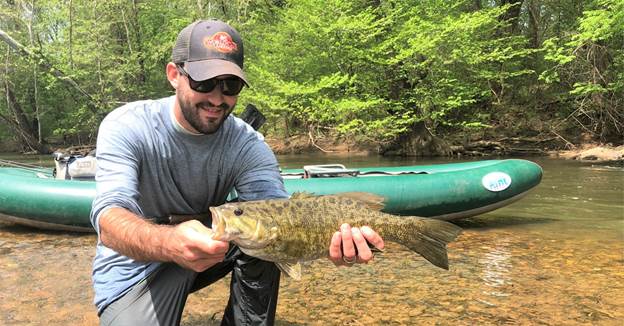
Joe Revercomb with a trophy James River smallmouth bass. This April smallmouth took a clouser minnow fished on a 250 grain full sinking line.
By Alex McCrickard, VDGIF Aquatic Education Coordinator
Anglers across the state often associate spring with trout fishing season. Mountain streams are typically in prime flow conditions during this time of the year, and spring hatches have the fish feeding regularly. However, trout shouldn’t be the only fish on anglers’ minds during this time of the year.
Spring also coincides with great opportunities to target smallmouth bass as rivers across the state warm up from the winter months. Water temperatures warming is a thermal cue that triggers increased metabolism and activity of smallmouth bass, creating excellent fishing conditions across the state for bronzeback enthusiasts.
On average years during late winter, water temperatures climb out of the 30s and into the 40s on rivers and streams across the state. As winter transitions to spring, water temperatures will continue to increase into the upper 40s and 50s. Smallmouth bass will react favorably to the warming trends and these fish will move out of the winter holes and into transitionary water in mid to late March. Now that it’s April, smallmouth can consistently be found holding in the middle of the water column behind mid-river boulders and along the edges of current seams where fast water meets slow water. These fish can also be found holding along ledges, drops offs, in riffles, and even along the banks.
Mid to late March signaled the beginning of pre-spawn activity for smallmouth bass. Spawning typically begins in late April and continues all through the month of May on our Virginia rivers and streams. During pre-spawn, smallmouth can be very aggressive as they get territorial and put on weight for the spawning season. These fish actively ambush smaller forage fish and crayfish during this time of the year. April can provide for exciting fishing during the pre-spawn feeding frenzy.

VDGIF aquatic education coordinator Alex McCrickard pauses during a float trip to fish from a mid-river boulder on the James River. Waffles, his trusty fishing dog, loves catching Virginia smallmouth. Photo by Walker Dales
Smallmouth bass are benthic spawners; males build nests in clean substrate including gravel, pebble, and cobble bottom. Males are cued to start this process when water temperatures climb into the 60s. These fish often seek out softer currents in 2 to 6 feet of water behind boulders, logs, or other obstructions when choosing spawning sites. Male smallmouth will dig a depression into the river bottom before spawning with a female.
After the spawn, males will stick around and guard their nests from aquatic and terrestrial predators. Spawning success is highly dependent on spring flows. High, muddy water from heavy spring rain events can impact smallmouth bass recruitment and spawning success. Because smallmouth are benthic spawners, high water in the spring time can wash beds out or cover them up with sediment, impacting recruitment and leading to variations in abundance of certain age classes within the population.
Spring can often coincide with high flows on rivers and streams across Virginia. Late winter snow melt and early spring rains can sometimes put rivers at flood level stages. Make sure to exercise caution during this time of the year and check the flows before you head to the river. In these high flows, smallmouth will orient to cover where they don’t have to fight super strong currents to find food. Even in high, muddy water, smallmouth are looking for meals and can be caught with a little persistence and determination as long as the river isn’t in flood stage.
It can be best to cover water when fishing for pre-spawn smallmouth bass. Floating the larger rivers during this time of the year is a great way to accomplish this, just remember to wear your personal flotation device. If you are wade-fishing smaller to medium-size rivers, don’t be afraid to do some hiking to cover ground on foot.
The pre-spawn bite is best approached by fishing subsurface minnow imitations through April. Make sure to have some crankbaits on hand in a variety of colors during this time of the year. Rattling lipless crankbaits or noisy lipped crankbaits can be productive when the water is high and stained. The Rat-L-Trap causes commotion that attracts spring bass in these conditions. Soft plastic swimbaits like the Keitech Swing Impact Swimbait or Sassy Shads work well and sink deep quickly when fished on a jig head. Flashy spinnerbaits also entice strikes from spring smallmouth in stained water conditions.

